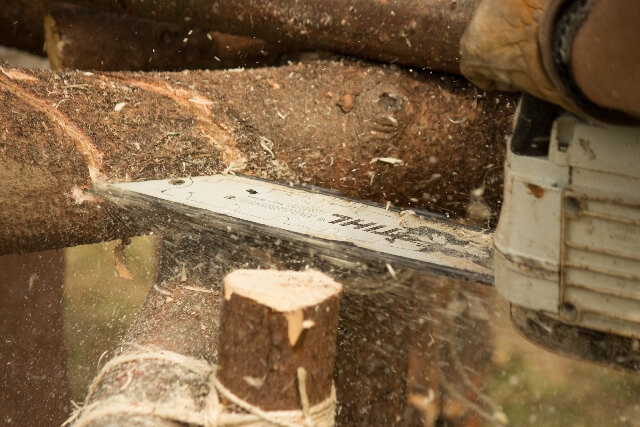Have you just finished a couple of carpentry jobs around the home? Then you may wonder is sawdust biodegradable or should I throw it away?
Sawdust is biodegradable as long as it is from untreated lumber. You can add it to your compost or even recycle it.
Are you thinking about throwing some sawdust onto your compost heap? Then find out more about how sawdust decomposes and its impact on the environment coming up next.
Everything you need to know about sawdust is right here.
Does Sawdust Decompose?
Sawdust is a natural material. It is simply the by-product of woodwork such as sawing. When sawdust comes from natural, untreated lumber it is biodegradable.
Sawdust decomposes quickly in the right environment. But what does that environment consist of? It includes the following:
- Not overdoing it. If you dump a whole load of sawdust onto your compost pile all at once it will take longer to break down. Sawdust needs a few other materials to be present for it to decompose quickly. Try adding sawdust to your compost in sections if you have a lot of it.
- Adding nitrogen-rich waste. Sawdust decomposes best when it is surrounded by nitrogen-rich waste. You should pile your sawdust between leaf clippings, grass cuttings, and kitchen compost waste. This will help your sawdust to decompose faster.
- Rotating the compost bin. You should rotate your compost pile periodically. Ideally, every 3 to 7 days. This helps to aerate the compost. As your compost matures, you can turn it less frequently.
- Moistening the compost. You should dampen the compost every 3 or 4 days. Sawdust quickly absorbs moisture. Keeping it damp will help the sawdust decompose faster.
What can we say are the best tips for decomposing sawdust? Add it to your compost bin little by little, along with some nitrogen-rich waste. You should also rotate the compost bin and keep it moist.
How Long Does It Take for Sawdust to Biodegrade?
So, you’re just about to throw some sawdust onto your compost but you’re unsure. How long will it be on the heap? Will it break down? In ideal conditions, sawdust will biodegrade completely within 6 months. But the length of this process from start to end depends on a number of factors. Let’s consider these one at a time.
- The amount of sawdust on the compost heap. Sawdust biodegrades best when it is accompanied by other natural materials. What if your compost heap is purely sawdust? Then you can expect the breakdown of the sawdust to take a lot longer.
- The presence of nitrogen-rich waste in the compost heap. Sawdust has a very high ratio of carbon to nitrogen. It needs to be surrounded by nitrogen-rich materials in order to break down. Is your compost is made up of leafy plants, grass cuttings, and fruit and vegetable waste? Then you can expect the sawdust to break down quickly.
- Turning the compost pile. The decomposition of your sawdust will be faster when the microbes in the compost can breathe. If there isn’t enough oxygen in the compost, the microbes will die off and the process will slow down. So, to accelerate the breakdown of your compost, make sure you turn it every 3 to 7 days.
- The moisture level in the compost pile. Sawdust needs to be moist for it to break down quickly. But it shouldn’t be too wet. If it is, the excess water will slow decomposition down.
Ok, so we’ve spoken a little about the ideal conditions for breaking down sawdust. But what if none of these conditions are possible? How long will it take for the sawdust to decompose? Sawdust could take years to decompose if the right conditions are not present.
Is Sawdust Bad for the Environment
Sawdust is a natural material that is good for the environment. It is simply a by-product of carpentry that you can upcycle. You can also recycle and compost sawdust. Microorganisms can quickly break down sawdust and it is great for plants when mixed with the right waste.
Is Sawdust Good for Anything?
Do you have a large amount of sawdust? If you’ve got more sawdust than your compost pile can handle, you might be looking for other ways of getting rid of it. But is there anything useful you can do with sawdust? Check out some of the most innovative ideas below.
- Grip your driveway. Driveways are slippy in the winter but sawdust can increase traction. Sprinkle some next down next time Jack Frost comes to town.
- Cleaning spills. Sawdust is brilliant at absorbing moisture. Why not keep a bucket to hand for use in the garage and handiwork areas. It will quickly absorb oil and paint spills.
- Fill wood holes. Mix sawdust with glue and putty and then use it to fill wood holes. This will give your carpentry jobs a smoother and neater finish.
- Make a path. If certain areas of your garden often get inundated with mud, lay a sawdust path over them. The sawdust will absorb the moisture and will make the turf easier to walk on.
- Feed your plants. Mix sawdust with nitrogen-rich waste and add that to the soil of your plants. They will soon show you just how much they love it.
Have these 5 tips whetted your appetite? Then make sure you check out some more crafty sawdust ideas in this video.
Final Thoughts
Do you have a lot of sawdust hanging around after a carpentry job? Then you might feel like it would be wasteful to just throw it in the trash. Is sawdust biodegradable? Can you put it in your compost bin?
As we have seen in this article, sawdust is completely biodegradable. This is because it is a natural material that can break down quickly in the right conditions. Simply add the sawdust to your compost, and turn and wet the pile frequently. With a little patience and the right foliage on top, your sawdust should mulch down in just a few months.


